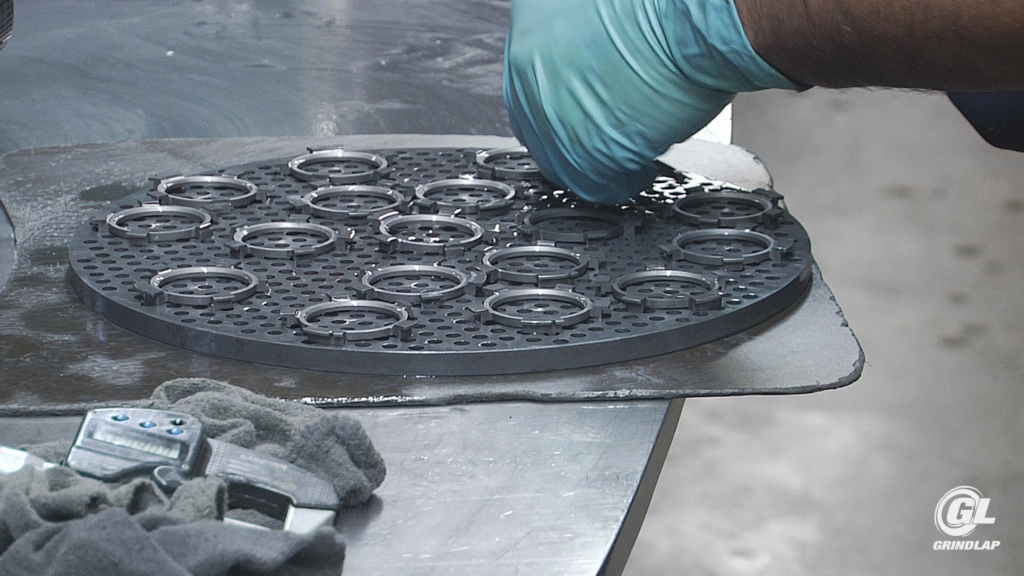Are you grappling with the challenge of achieving precise, smooth surfaces in your manufacturing processes? Whether you operate in aerospace, defense, or medical device manufacturing, maintaining exacting standards can be daunting. The benefits achieved from flat lapping are many.
With a deep-rooted commitment to precision machining, Grind Lap specializes in both single and double-sided flat lapping—a technique renowned for its ability to deliver impeccable surface finishes and dimensional accuracy. Our expertise ensures that components meet the most demanding specifications across diverse industries.
In this article, we’ll explore the transformative advantages of flat lapping. From achieving surface finishes as fine as 0.025 microns (1 Ra) and flatness within one helium light band (.0000116”) to optimizing production efficiency and cost-effectiveness, discover how this versatile process can elevate your manufacturing capabilities. Gain actionable insights to enhance your processes, adhere to rigorous quality standards, and excel in competitive markets.

Understanding the Benefits Achieved from Flat Lapping
Flat lapping is a precision machining process used to create smooth and flat surfaces on a variety of materials. The process involves using abrasive particles on a rotating surface to remove material and create a precise surface finish and flatness. Flat lapping is a popular manufacturing technique that offers numerous benefits, including improved accuracy, increased efficiency, and enhanced productivity.
Achieving High Accuracy and Precision
One of the most significant advantages of flat lapping is its ability to produce parallel, flat and smooth surfaces with high accuracy. The process can achieve surface finishes of up to 0.025 microns (1 Ra) and flatness within one helium light band (.0000116”), which is essential in industries such as aerospace, defense, and medical device manufacturing, where precision and accuracy are crucial. With flat lapping, manufacturers can produce high-quality components that meet the required specifications and tolerances.
Enhancing Efficiency Another Benefit Achieved from Flat Lapping
Another of the many benefits achieved from flat lapping is its efficiency. Unlike other manufacturing processes such as milling or grinding, flat lapping uses a rotating plate and abrasive particles to remove material, allowing for the creation of parallel, flat and smooth surfaces quickly. This efficiency is particularly important in industries where time is of the essence, such as automotive and electronics manufacturing, where production needs to be fast and reliable.
Versatility in Creating Complex Geometries
Flat lapping can also be used to create complex shapes and geometries on a variety of materials, including metals, ceramics, and plastics. This versatility makes it an essential process in the manufacturing of components for a range of industries. For example, in the semiconductor industry, flat lapping is used to create precise shapes and geometries on silicon wafers, while in the medical device industry, it is used to create smooth surfaces on implantable devices.
Ensuring Consistent Surface Finish
The process of flat lapping also produces a consistent surface finish across large areas. This is important in industries that use seals and microchips, where even the slightest imperfection can affect the overall performance of the component. With flat lapping, manufacturers can produce components with a uniform surface finish, ensuring that they perform optimally.
Cost-Effectiveness
Finally, flat lapping is a cost-effective process for manufacturers. The process is relatively straightforward, requiring only a few tools and machines, making it a cost-effective option compared to other manufacturing processes. Additionally, the process requires minimal maintenance, further reducing costs and increasing productivity.
Conclusion: The Benefits Achieved from Flat Lapping
In conclusion, both single and double-sided flat lapping is a versatile and efficient manufacturing process that offers numerous benefits, including improved accuracy, increased efficiency, enhanced productivity, and cost-effectiveness. The process is ideal for creating precise surfaces and complex shapes on a variety of materials, making it a popular choice for industries such as aerospace, defense, electronics, and medical device manufacturing. As such, flat lapping is likely to continue to play a critical role in the manufacturing industry for years to come.


Recent Comments